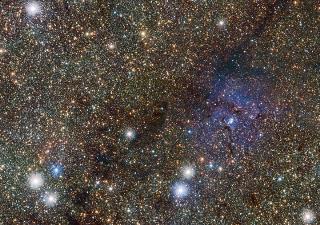Feb 5 2015
As one of its major surveys of the southern sky, the VISTA telescope at ESO's Paranal Observatory in Chile is mapping the central regions of the Milky Way in infrared light to search for new and hidden objects. This VVV survey (standing for VISTA Variables in the Via Lactea) is also returning to the same parts of the sky again and again to spot objects that vary in brightness as time passes.
 This small extract from the VISTA VVV survey of the central parts of the Milky Way shows the famous Trifid Nebula to the right of centre. It appears as faint and ghostly at these infrared wavelengths when compared to the familiar view at visible wavelengths. This transparency has brought its own benefits -- many previously hidden background objects can now be seen clearly.(Credit:ESO/VVV consortium/D. Minniti)
This small extract from the VISTA VVV survey of the central parts of the Milky Way shows the famous Trifid Nebula to the right of centre. It appears as faint and ghostly at these infrared wavelengths when compared to the familiar view at visible wavelengths. This transparency has brought its own benefits -- many previously hidden background objects can now be seen clearly.(Credit:ESO/VVV consortium/D. Minniti)
A tiny fraction of this huge VVV dataset has been used to create this striking new picture of a famous object, the star formation region Messier 20, usually called the Trifid Nebula, because of the ghostly dark lanes that divide it into three parts when seen through a telescope.
The familiar pictures of the Trifid show it in visible light, where it glows brightly in both the pink emission from ionised hydrogen and the blue haze of scattered light from hot young stars. Huge clouds of light-absorbing dust are also prominent. But the view in the VISTA infrared picture is very different. The nebula is just a ghost of its usual visible-light self. The dust clouds are far less prominent and the bright glow from the hydrogen clouds is barely visible at all. The three-part structure is almost invisible.
In the new image, as if to compensate for the fading of the nebula, a spectacular new panorama comes into view. The thick dust clouds in the disc of our galaxy that absorb visible light allow through most of the infrared light that VISTA can see. Rather than the view being blocked, VISTA can see far beyond the Trifid and detect objects on the other side of the galaxy that have never been seen before.
By chance this picture shows a perfect example of the surprises that can be revealed when imaging in the infrared. Apparently close to the Trifid in the sky, but in reality about seven times more distant, a newly discovered pair of variable stars has been found in the VISTA data. These are Cepheid variables, a type of bright star that is unstable and slowly brightens and then fades with time. This pair of stars, which the astronomers think are the brightest members of a cluster of stars, are the only Cepheid variables detected so far that are close to the central plane, but on the far side of the galaxy. They brighten and fade over a period of eleven days.